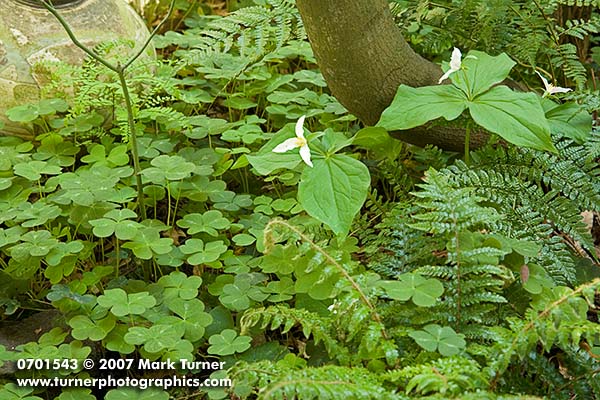Trilliums
One of my favorite wildflowers, dating back to my childhood, is the trillium. I grew up in central West Virginia and in the spring one hillside along the road to my grandparents home was always covered with large white trilliums, Trillium grandiflorum. When I moved to Washington state I learned that our native trillium here, which looks quite similar to the eastern white trillium, is Trillium ovatum. Both of them can be grown successfully in Northwest gardens.

I photographed in a Tacoma-area garden recently where there were a couple of patches of trilliums planted. In this photo, they’re mixed with redwood sorrel, Oxalis oregana, and a non-native fern. This planting is practically inside the house where it can be easily enjoyed. Elsewhere in the garden was a larger patch of trilliums, which had been self-seeding and establishing a rather nice large patch of flowers. The gardener pointed out to me that first-year trillium seedlings have a single leaf, second-year seedlings have two leaves, and not until their third year do they develop their typical three leaves.
Speaking of counting trillium leaves, a couple of people have posted on native plant discussion lists this spring about having seen trilliums with unusual leaf counts — four or five leaves and petals. No one was able to come up with a definitive answer to the question, “why?”.
Of course, the large white trillium isn’t the only species found in the northwest, but the others don’t generally range as far north as where I live near the Canadian border. Down in Oregon you’ll find the sessile species Trillium albidum, Trillium chloropetalum, and Trillium kurabayashii, and the diminutive Trillium rivale. Trillium petiolatum grows over in the Wenatchee mountains. They’re all worth seeking out when wandering around the woods in the spring.


Hi, I got a few amazing shots recently in Mass where I found some RED, or PURPLE Trillium Erectum. Exciting! I recently located a plant that I cannot seem to find anyplace, with a yellow flower, ever-so-delicate, growing on the top of a steep cliff in a damp moist wooded area atop a granite rock bed. The patches seem to favor the sunlight, and I am musing that they also like acidic soil, because of other plants which I found around them of course (including the red trillium grandiflora). If you can see my email address do email me, or look me up on my blog site above.
In regards to Trillium, I have heard it is getting harder and harder to find because of changelings and hybrids…
Jennifer